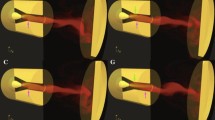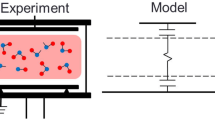Abstract
Thin film technologies are generally based on plasma-supported methods (see Fig. 4.1). Plasma means:
- When in a liquid or a gas the number of free charge carriers is so large that charge carriers affect the physical properties of the medium substantially.
- When electromagnetic interactions between the charged particles take place.
- When the number of positive and negative charge carriers is for each unit of volume equally large in each case; the total quantity can be arbitrary.
Access this chapter
Tax calculation will be finalised at checkout
Purchases are for personal use only
Similar content being viewed by others
References
Cap F (1970) Einführung in die Plasmaphysik I. Pergamon Press, Oxford
Linhart JG (1960) Plasma Physics. North Holland Publishing C., Amsterdam
Chandrasekhar S (1960) University of Chicago Press. Plasma Physics :
Maxwell JC (1954) A Treatise on Electricity and Magnetism (891). Dover Publications, Inc., New York
Mongomerry D, Tidman D (1964) Plasma Kinetic Theory. McGraw Hill, New York
Kunkel M (1966) Plasma Physics in Theory and Application. McGraw Hill,
Dupree, A: Phys. Fluids 4, 696 (1961); 6, 1714 (1963)
Sears FW (1950) An Introduction to Thermodynamics, The Kintetic Theory of Gases and Statistical Mechanics. Addision-Weseley Press, Inc., Reading, Mass.
CODATA Recommended Values. National Institute of Standards and Technology, abgerufen am 20. Juni 2011. Wert für die Rydberg-Konstante
Cobine JD (1958) Gaseous Conductors. Dover Publications, Inc., New York
Phelps AV, Molnar JP (1963) Phys Rev 89:1202
Chuan, R.L.: A Note on the Adition of Heat to a Gas through Electrical Discharge, USCEC Rept. 68-202, January, 1957
Loeb LB (1956) The recombination of ions Handbuch der Physik, vol. XXI. Springer-Verlag, Berlin
Massey HSW, Burhop EHS (1952) Elektronic and ionic impact phenomena. Oxford University Press, Fair Lawn
Saha MN (1920) Ionization in the solar chromosphere. Phil Mag 40(238):472
Bond, J. W., Jr.: The nature of shock front in argon. Los Alamos: Sci.Lab.Rept.LA-1693, Juli 1, 1954
Moore, C.E.: Atomic energy levels. Nat. Bureau of Standards Circ. 467 Vls. I,II and III. Washington: 1949, 1952 und 1958
Laporte O (1958) High temperature shock waves. In: Third AGARD Colloquium on Combustion and Propulsion. Pergamon Press, New York, p 499
Ohlsen HH (1961) Partition function cut-off and lowering of the ionization potential in an argon-plasma. Phys Rev 124(4):1703
Paschen, F.: Ann.Phys. (4 Folge) 50, p.901 (1889)
Penning FM (1957) Electical Discharges in Gases. The Macmillian Company, New York
Schulz P (1974) Elektronische Vorgänge in Gasen und Festkörpern. Verlag O. Braun, Karlsruhe
Davies WD, Vanderslice TA (1993) PhysRev 131:219
Westwood WD, Wilcox PC (1972) J Appl Phys 42:4099
Little PF, von Engel A (1954) The hollow cathode effect and the theory of glow discharges. Proc Roy Soc A 224:209
Musha T (1962) Cathode sputtering in hollow cathode discharges. J Phys Soc Japan 17:1440
Penache C., Study of high-pressure glow discharges generated by micro-structured electrode (MS) arrays, Dissertation J.W. Goethe Universität Frankfurt Main (2002)
Mildner M, Korzec D, Engemann J (1999) 13.56 MHz hollow cathode jet matrix plasma source for large area surface coating. Surface and Coating Techn 112:366
Delcroix JL, Trinidade AR (1974) Advanc In Electronics and Electron Phys 35:87
Brown SC (1959) Basic data of plasma physica. John Wiley, New York
Wolf B (1995) Handbook of Ion Sources. CRC Press, Boca Raton
Sager O (1969) Frequency analysis of the probe current in an RF discharge. Proc IEEE 57:227
Editor information
Editors and Affiliations
Rights and permissions
Copyright information
© 2015 Springer-Verlag Berlin Heidelberg
About this chapter
Cite this chapter
Frey, H. (2015). Basic Principle of Plasma Physics. In: Frey, H., Khan, H.R. (eds) Handbook of Thin-Film Technology. Springer, Berlin, Heidelberg. https://doi.org/10.1007/978-3-642-05430-3_4
Download citation
DOI: https://doi.org/10.1007/978-3-642-05430-3_4
Publisher Name: Springer, Berlin, Heidelberg
Print ISBN: 978-3-642-05429-7
Online ISBN: 978-3-642-05430-3
eBook Packages: Chemistry and Materials ScienceChemistry and Material Science (R0)




